
29.12.09
18.12.09
Locality 55 (North West Pennsylvania, US) White Christmas (3d)
 I'm dreaming of a white Christmas
I'm dreaming of a white ChristmasJust like the ones I used to know
Where the treetops glisten,
and children listen
To hear sleigh bells in the snow
I'm dreaming of a white Christmas
With every Christmas card I write
May your days be merry and bright
And may all your Christmases be white
Irving Berling, 1940.
Anaglyph photo: ian5281
26.11.09
Locality 54 (Ontario, Canada) Rememberance of Things Past

I feel that there is much to be said for the Celtic belief that the souls of those whom we have lost are held captive in some inferior being, in an animal, in a plant, in some inanimate object, and so effectively lost to us until the day (which to many never comes) when we happen to pass by the tree or to obtain possession of the object which forms their prison. Then they start and tremble, they call us by our name, and as soon as we have recognised their voice the spell is broken. We have delivered them: they have overcome death and return to share our life.
And so it is with our own past. It is a labour in vain to attempt to recapture it: all the efforts of our intellect must prove futile. The past is hidden somewhere outside the realm, beyond the reach of intellect, in some material object (in the sensation which that material object will give us) which we do not suspect. And as for that object, it depends on chance whether we come upon it or not before we ourselves must die.
Marcel Proust, Rememberance of Things Past, 1913.
Photo: Kronix
16.11.09
Locality 53 (Christiania, Copenhagen) Free Town
 The Treehouse Song
The Treehouse Song When I woke
I took the backdoor to my mind
and then I spoke
I counted all of the good things you are
and that list of charms was
longer than my chain of broken hearts
and when the day was done
I figured I had already lost
from the start – from the start
I was gonna love you till the end of all daytime
and I was gonna keep all our secret signs and our lullabies
I was made to believe that our love would grow old
we were gonna live in a treehouse and make babies
and we were gonna bury our ex-lovers and their ghosts
baby we were made of gold
Ane Brun, The Treehouse Song, 2008.
Photo: Jaafar Mestari
31.10.09
Locality 47-52: Merz
 Hamburg-Finkenwerder, Germany. Tdietmut
Hamburg-Finkenwerder, Germany. Tdietmut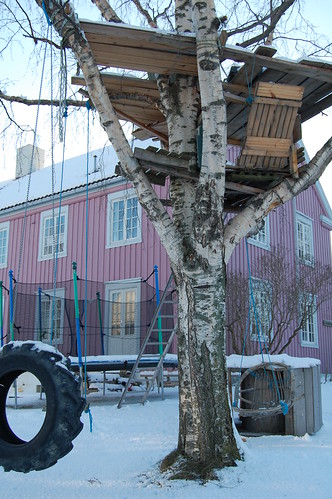 Rotvoll, Norway. Astridsol
Rotvoll, Norway. Astridsol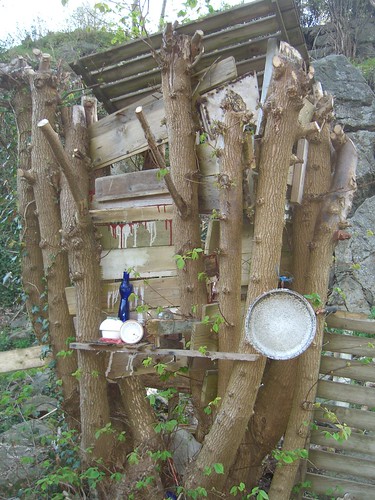 North Sea Cycle Route. Kalevkevad
North Sea Cycle Route. Kalevkevad
Central Illnois, US. Larryt135
 Merzbau, Hannover 1933. Kurt Schwitters.
Merzbau, Hannover 1933. Kurt Schwitters.
26.10.09
Locality 46 (Little Falls, NY) Keeping out of trouble

Explorer Bartzilla reports from an expedition into his own youth:
"Whoever nailed that ladder into the side of the tree must have done it long ago since those slats of wood couldn't support anything these days. This wasn't our original ladder into the fort. Ours was on the other side and a bit more accessible.
The fire pit we had dug and circled with rocks was also washed away, as were the log benches we had put around it. I'm tellin' ya, we went all out on this project. Plus, for the most part, it kept us out of trouble on summer vacations, even if we might have been up to no good up there.
One afternoon of construction, I was blowing off some firecrackers and we saw a policeman doing his commando thing with his shotgun up to the fort. He knew what we were up to and actually just told us to knock it off with the firecrackers and then proceeded to admire our handy work and give us his history of the tree fort that his friends had built in this tree."
23.10.09
Locality 45 (Fevik) We need shelter
"You wouldn't care to help with the shelters I suppose?"
"We need meat"
"We need shelters"
"Are you accusing-"
"All I'm saying is we've worked dashed hard. That's all... Do you want to be rescued? All you talk about is 'pig pig pig'"
"We want meat"
"And I work all day with nothing but Simon and you come back and don't even notice the shelters"
"I work too"
"But you like your work. You enjoy yourself hunting. While I-"
"Do a bit for you before I have a bathe"
"Don't bother"
Peter Brook, screenplay adaptation of William Golding's Lord of the Flies, 1963, deleted scene.
 Søm-Ruagerkilen Nature Reserve at Fevik, 2009.
Søm-Ruagerkilen Nature Reserve at Fevik, 2009.
Locality 44 (Brentwood, TN): I sit and look
 I sit and look
I sit and look I sit and look out upon all the sorrows of the world, and upon all
oppression and shame;
I hear secret convulsive sobs from young men, at anguish with
themselves, remorseful after deeds done;
I see, in low life, the mother misused by her children, dying,
neglected, gaunt, desperate;
I see the wife misused by her husband--I see the treacherous seducer
of young women;
I mark the ranklings of jealousy and unrequited love, attempted to be
hid--I see these sights on the earth;
I see the workings of battle, pestilence, tyranny--I see martyrs and
prisoners;
I observe a famine at sea--I observe the sailors casting lots who
shall be kill'd, to preserve the lives of the rest;
I observe the slights and degradations cast by arrogant persons upon
laborers, the poor, and upon negroes, and the like;
All these--All the meanness and agony without end, I sitting, look out
upon,
See, hear, and am silent.
Walt Whitman, Leaves of Grass - 1871 ed.
Photo: Majtek862
19.10.09
Locality 43: A poem lovely as a tree
 I think that I shall never see
I think that I shall never seeA poem lovely as a tree
-Joyce Kilmer, Trees, 1913
Photo: Lex van de Oudeweetering
30.9.09
The unknown

We do not know who was here before us,
or where they are now.
We dont even know if they were the ones
that made thís scene.
All we know is that this "home" is very
much alive, and i think we just moved in.
15.9.09
7.9.09
Locality 41 (Lindesnes) Transitory
 At Lindesnes Bygdemuseum, this photo depicts two young architects that were never properly credited for their work. Around 1964 (judging from other contemporary photos), Atti Eikaas on the roof, and Odd Terje Vigeland in the doorway, built this magnificent hut. Now the photo is all that remains of it. Apparently, only buildings constructed by adults are worthy of preservation.
At Lindesnes Bygdemuseum, this photo depicts two young architects that were never properly credited for their work. Around 1964 (judging from other contemporary photos), Atti Eikaas on the roof, and Odd Terje Vigeland in the doorway, built this magnificent hut. Now the photo is all that remains of it. Apparently, only buildings constructed by adults are worthy of preservation.Kid huts may compare better to Buddhist sand mandalas. A sand mandala is ritualistically destroyed once it has been completed and its accompanying ceremonies and viewing are finished to symbolize the Buddhist doctrinal belief in the transitory nature of material life. It is the doing that is important, not the artefact. Childhood is transitory. But then again, so is adulthood.
2.9.09
Locality 40 (Arlington, VA, USA) Down memory lane
 On the first of May, 1977, at latitude 38.893036 and longitude 77.10101, expedition member Ken Mayer came into the view of a camera lense. The 3-story monstrosity was built from scrap found along the I-66 right-of-way, where torn down houses and businesses along the former railroad line provided plenty of materials.
On the first of May, 1977, at latitude 38.893036 and longitude 77.10101, expedition member Ken Mayer came into the view of a camera lense. The 3-story monstrosity was built from scrap found along the I-66 right-of-way, where torn down houses and businesses along the former railroad line provided plenty of materials."I often feel that city-planners fail to recognize the need for free spaces for kids to create their own stuff. In our case, a 20-year fight over an interstate highway created a great over-grown no-man's-land of ruins and forest" says Mayer in a retrospective comment. Although clearly marked "Private", the remains of the hut are now buried below the highway, waiting to be rediscovered.
26.8.09
30.7.09
Locality 39 (Aigle, Switzerland) Unintended Installation
 In the forest, near "Aigle", Switzerland, artist and explorer Nicolas Geiser came across this kid hut on slim tree stilts, reachable by a long ladder made of two poles with plank steps. The hut is constructed so that no two boards are alike, nor of the same length. And the "door" is actually a rug. Creativity is the mother of invention.
In the forest, near "Aigle", Switzerland, artist and explorer Nicolas Geiser came across this kid hut on slim tree stilts, reachable by a long ladder made of two poles with plank steps. The hut is constructed so that no two boards are alike, nor of the same length. And the "door" is actually a rug. Creativity is the mother of invention.
9.7.09
Locality 38 (Arendal) Ascent at Paradise Bay
 Using our expedition boat, a GH 14 with a Yamaha 9,9 HP outboard motor, we are now able to navigate into unexplored bays and islets in the archipelago outside the South Coast of Norway. At Paradise Bay on the small island Havsøy outside of Arendal, a large Ash invited itself to be explored. Somebody had mounted a small swing from one of the branches. At the top of the tree we thought we could discern a small tree hut, but could not be sure from our position on the ground.
Using our expedition boat, a GH 14 with a Yamaha 9,9 HP outboard motor, we are now able to navigate into unexplored bays and islets in the archipelago outside the South Coast of Norway. At Paradise Bay on the small island Havsøy outside of Arendal, a large Ash invited itself to be explored. Somebody had mounted a small swing from one of the branches. At the top of the tree we thought we could discern a small tree hut, but could not be sure from our position on the ground. Choosing a moment when no-one seemed near, we leapt sinuous and catlike, into the lower branches of the forest giant. Silently we climbed to a great height until we found a point where we could look through a leafy opening upon the scene beneath us.
Choosing a moment when no-one seemed near, we leapt sinuous and catlike, into the lower branches of the forest giant. Silently we climbed to a great height until we found a point where we could look through a leafy opening upon the scene beneath us.

 We had now ascended to the structure we could discern from the ground, and from this angle we realized that it was more of a look-out tower at the top of the forest canopy than a proper hut. A floor, but no walls or roof, the structure was nevertheless sturdily built, and the bent spikes told the tale about the young builders. How on earth they had managed to get up there remained a mystery until we found remains of past ropes that in the past must have made the ascent at Paradise Bay a breeze.
We had now ascended to the structure we could discern from the ground, and from this angle we realized that it was more of a look-out tower at the top of the forest canopy than a proper hut. A floor, but no walls or roof, the structure was nevertheless sturdily built, and the bent spikes told the tale about the young builders. How on earth they had managed to get up there remained a mystery until we found remains of past ropes that in the past must have made the ascent at Paradise Bay a breeze.
1.7.09
Locality 37 (Northwest Pennsylvania, US) Anaglyph
 Ah, the wonders of MODERN SCIENCE! Thanks to the TECHNOLOGICAL ADVANCEMENTS of the 19th century, explorer Ian5281 has provided us with an anaglyph of a snow fort discovered in northwest Pennsylvania, US. This AMAZING STEREOSCOPIC IMAGE may be FULLY appreciated by explorers equipped with a standard set of 3d glasses, such as the one depicted below. NO EXPLORER WOULD DARE LEAVE HOME WITHOUT IT!
Ah, the wonders of MODERN SCIENCE! Thanks to the TECHNOLOGICAL ADVANCEMENTS of the 19th century, explorer Ian5281 has provided us with an anaglyph of a snow fort discovered in northwest Pennsylvania, US. This AMAZING STEREOSCOPIC IMAGE may be FULLY appreciated by explorers equipped with a standard set of 3d glasses, such as the one depicted below. NO EXPLORER WOULD DARE LEAVE HOME WITHOUT IT!
Ah, how fitting that this EXOTIC PHOTOGRAPH of a snow fort should be featured on this summer edition of our INQUISITIVE AND INFORMATIVE BLOG, looking into the MYSTERIES OF CHILDHOOD. We wish our fellow explorers a HAPPY SUMMER HOLIDAY! And do beware of those ULTRAVIOLET RAYS. Tans may come and go, but MEMORIES LAST FOREVER!
18.5.09
Locality 36 (Martinsburg, West Virginia) Simple Living
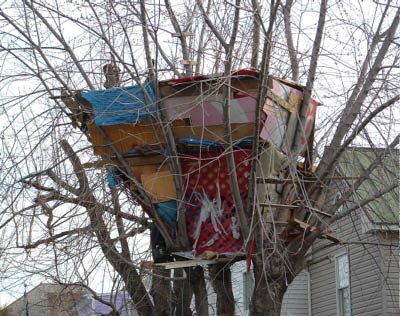
Explorer Dr. Boden managed to document this tree construction in Martinsburg, West Virginia before the city made the young constructor James demolish the site on claims it was an "eye sore". But with this more substantial shelter about him, he had made some progress toward settling in the world. This frame, so slightly clad, was a sort of crystallization around him, and reacted on the builder. It was suggestive, somewhat as a picture in outlines. He did not need to go outdoors to take the air, for the atmosphere within had lost none of its freshness. "An abode without birds is like a meat without seasoning".
4.5.09
Det norske huset
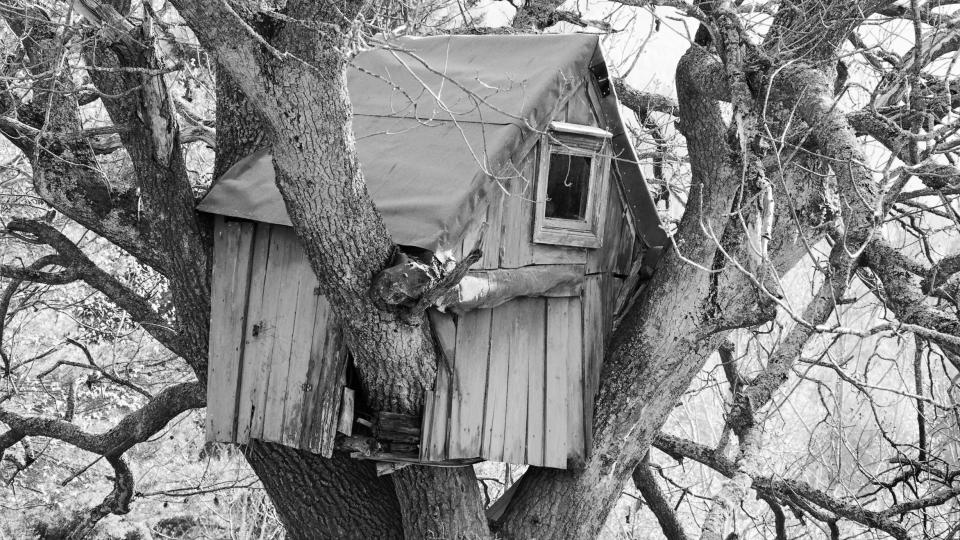
Frode Grytten and photographer Jens Hauge have been on extensive kid hut expeditions and present their reports in the book "Det norske huset". According to Dagbladet, the starting point for the book project was close to 70 b/w photographies of Norwegian kid huts, documented by Hauge across the last 20 years, everything from small shacks in the trees, sheet metal huts and snow castles to strange tunnelways, crooked verandas and more elaborate constructions resembling art installations. . .
13.4.09
Locality 27-35 (Fevik) A Survey

We now publish the preliminary results of the survey conducted within the Søm-Ruagerkilen Nature Reserve at Fevik, Norway. The area only became protected in 2006, and contains a birch forest housing a wealth of biological diversity, as well as the Ruagerkilen lagoon sheltered from the open sea and containing a number of sea birds.
 The survey discovered as many as 9 different localities within the area. The density of huts was particularly striking in the immediate proximity to the lagoon itself, making it likely that the same constructors were responsible for most of these huts. All of these were basic tree huts at various stages of completion, constructed mainly from wooden boards.
The survey discovered as many as 9 different localities within the area. The density of huts was particularly striking in the immediate proximity to the lagoon itself, making it likely that the same constructors were responsible for most of these huts. All of these were basic tree huts at various stages of completion, constructed mainly from wooden boards.



However, there were also two other localities that displayed a completely different culture, notably locality 27, and 32. The former was in fact the most concealed site, located only 20-25 metres from a dirt road at the outskirts of the forest, and the last to be discovered. The site consisted of a sort of rough A-shape shelter built from tree branches and some additional tarpauling. The attempt at concealing the hut makes sense given that it was actually located within the protected forest, making it illegal. However, all of these localities were actually within the protected area.

The only other hut bearing any likeness to loc. 27, was loc. 32, which was found within the protected forest itself. This was also constructed in the manner of a shelter, although missing a full cover. An old hand saw was found at the site, perhaps suggesting that the hut was of considerable age and may have been built before the area became protected. However, it should be noted that both these latter localities were ecologically built, using rope and branches and carefully blending in with the landscape, on the border of making them invisible.

7.4.09
Locality 26 (Basel, Switzerland) The Lilliputians are coming
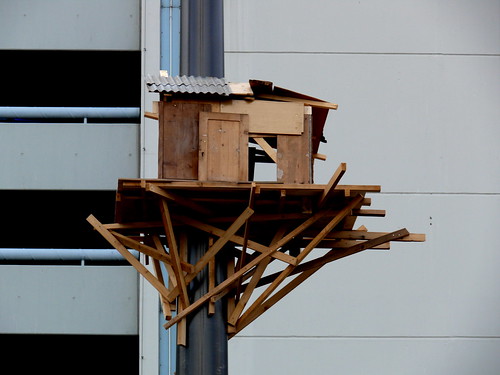 Intrepid explorer Gulliver Lorpailleur discovered this miniature construction 3/4 up a street lamp in Basel. Obviously the constructors must be illegal immigrants from a remote nation of the world. "Hekhinah Degul" indeed.
Intrepid explorer Gulliver Lorpailleur discovered this miniature construction 3/4 up a street lamp in Basel. Obviously the constructors must be illegal immigrants from a remote nation of the world. "Hekhinah Degul" indeed.
29.3.09
Locality 25 (Port Allen, Louisiana, US) The Castle
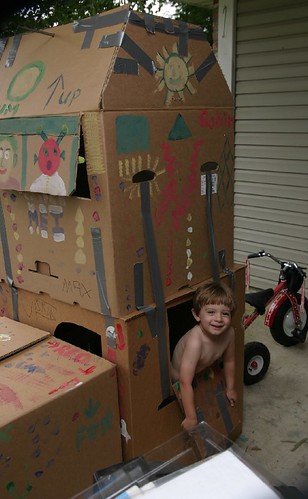
7.3.09
Locality 24 (San Luis Obispo CA, US) The Giving Tree

Veteran explorer Aroid shares stories about the hut next to the Cypress tree in his family's back yard in August 1960.
"Chuck had his fort in this tree, using bike crates for wood. Then he cut off key branches to keep us from gaining access. He tore down the fort--as much fun as building it.
Mom had something to say about us building our own fort. Clearly she did not get it. Munther the gardener built us a "nice" fort, with a concrete floor, properly put together. You can see it there, the first storey, with what was a window.
Then we took over, adding stories and taking it up into the old cypress tree.
I was always surprised how junky mom let us make this area. Then one day she suggested we clean it up, and we tore the fort down. The end of an era. Then she had the whole area professionally landscaped and it lost all interest for us. Became like a mall or a development. I guess she figured it was time, and she was right. "
 1. I spent many an afternoon around here, and noticed a Painted Lady butterfly made regular rounds, often landing near the tree.
1. I spent many an afternoon around here, and noticed a Painted Lady butterfly made regular rounds, often landing near the tree.2. Chuck cut off a key low-hanging branch right here, that you had to swing over to get up into the tree. without it us short kids could not climb it. we may have had a way into the tree by using the fence.
3. The tree had resin exuding from it, which we got on our hands, and smelled of. The bark was redder below, and shredded. It had tiny green splotches on it.
4. Each of these branches, and crevices was familiar to me, how you had to stretch to get across them, it all seemed wonderfully primal, but i did not know that word at the time. It was exciting to climb as high as you could.
5. We spent a lot of time climbing around in this tree. When friends would come over I was surprised they could not scramble around in it also, because it was unfamiliar to them. It had become second nature to me. I love being up in trees, looking out.
6. Perhaps the most foolish thing I ever did was climb to the top of this tree with a coil of steel cable and throw it out and over the power line to the left. When it hit the ground all hell broke loose. Sparks flew, cable was being where it crossed the wires, and falling to the ground.
7. We got bags of new nails at Forden's Hdwr. Freddy Waters noted that we wasted nails when we had a lot of them, and were very careful when we were just about out. That always stuck in my head, his observation.
8. Chuck showed us how to straighten bent nails with a hammer and use them again. He was always hammering and building things as a child.
9. A second cypress tree grew off to the left, but it was always a runt. I climbed up in it once all by myself, must have been really little, and got stuck, and Mr. Gillardi had to be summoned to get me out.
10. this fence was taken down and replaced as part of the new order, about 1961, and nasty ivy was planted all around, and boring shrubs.
3.3.09
Locality 23 (Dunstan, England) Cottage Inn
 Explorer Rojabro reports that "In addition to a large children's play area, there is a tree house in the woods at the Cottage Inn in Dunstan. near Craster and Dunstanburgh Castle"
Explorer Rojabro reports that "In addition to a large children's play area, there is a tree house in the woods at the Cottage Inn in Dunstan. near Craster and Dunstanburgh Castle"
8.2.09
Locality 22 (Crespano del Grappa, Italy) Child dream
 Expedition member Stezz managed to photograph this deserted tree hut at these coordinates: 45°50'17"N, 11°49'57"E, noting that it was "every child's dream". Voglio vivere su un albero...
Expedition member Stezz managed to photograph this deserted tree hut at these coordinates: 45°50'17"N, 11°49'57"E, noting that it was "every child's dream". Voglio vivere su un albero...
31.1.09
Locality 20 (San Fransisco) In the mission
 In the following, we will post photos and short reports from Kid Hut Expedition members all over the world through our Explorers club on Flickr. The first post in this series derives from Expedition member Drain's explorations in San Fransisco, US., Albion Street near 17th. "In the mission...I wonder who stays there".
In the following, we will post photos and short reports from Kid Hut Expedition members all over the world through our Explorers club on Flickr. The first post in this series derives from Expedition member Drain's explorations in San Fransisco, US., Albion Street near 17th. "In the mission...I wonder who stays there".
26.1.09
Locality 19: What the snow covered (Arendal)

It is not always the shortest way that is the best; here, in any case, it was to be hoped that another and longer one would offer better conditions. The shortest way was awful — possibly not altogether impracticable, if no better was to be found. First we had to work our way across a hard, forested slope, which formed an angle of 45 degrees, and ended in a huge, bottomless chasm. It was no great pleasure to cross over here on ski, but with heavily-laden sledges the enjoyment would be still less.
 The prospect of seeing sledge, driver, and dogs slide down sideways and disappear into the abyss was a great one. We got across with whole skins on ski, and continued our exploration.
The prospect of seeing sledge, driver, and dogs slide down sideways and disappear into the abyss was a great one. We got across with whole skins on ski, and continued our exploration.

Partly concealed in the snow, we came across what appeared to us as an ancient Indian burial ground, similar to the ones found in the Mid-West parts of what is now USA.The fact that we were not able to find any remains of human bones at the site, may suggest that local birds of prey had already devoured the corpses according to custom.



